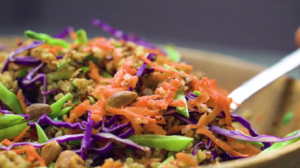Satisfy your cravings with this hearty pork and kimchi soup. A wonderful blend of spicy, tangy kimchi and tender pork makes this a unique, comforting dish. Perfect for those who want to try out Korean cuisine at home, you'll love the exciting flavors this soup brings to your table.
Kimchi, a key ingredient in this recipe, is a traditional Korean staple made from fermented cabbage and radish. You may need to visit an Asian grocery store or purchase it online if it's not available in your local supermarket. Also, hot pepper paste, another ingredient, is a spicy Korean condiment used in a variety of dishes. It can also be found in most Asian markets or the international section of a well-stocked grocery store.
Pork and Kimchi Soup Ingredients
Kimchi: A spicy, fermented cabbage that adds a unique flavor to the soup. Kimchi juice: The liquid from the kimchi jar, packed with flavor. Pork shoulder: A cut of meat that's flavorful and becomes tender after cooking. Hot pepper paste: Adds heat and a depth of flavor. White sugar: Balances out the heat and sourness. Water: The base of the soup. Tofu: Adds protein and soaks up the soup's flavor. Green onions: Adds a fresh, mild onion flavor.
One reader, Jessalyn Thibodeau says:





This pork and kimchi soup recipe is a game-changer! The flavors are incredibly rich and satisfying. The combination of tender pork, tangy kimchi, and spicy hot pepper paste creates a perfect harmony. It's a comforting and hearty dish that's now a staple in my kitchen. Highly recommended!
Cooking Techniques for Pork and Kimchi Soup
How to prepare the pork and kimchi soup: A step-by-step guide on how to combine the ingredients, cook the soup, and add the tofu and green onions.
How to cut the pork shoulder: Trim any excess fat from the pork shoulder and cut it into bite-sized pieces for the soup.
How to add the tofu: Gently add the tofu to the soup and allow it to heat through without breaking apart.
How to serve the pork and kimchi soup: Ladle the soup into bowls and garnish with additional green onions if desired. Serve warm and enjoy!
How To Make Pork and Kimchi Soup
Tantalize your taste buds with this spicy kimchi soup, packed with soft tofu and tender pork, simmered with hot pepper paste and tangy kimchi juice.
Serves:
Ingredients
- 2cupskimchi,chopped
- 2cupskimchi juice
- ½lbpork shoulder,cut into bite-sized pieces
- 2tbsphot pepper paste
- 1tspwhite sugar
- 5cupswater
- 14oztofu,(1 package), cut into bite-sized pieces
- 2green onions,chopped
Instructions
-
Combine the kimchi, kimchi juice, pork, hot pepper paste, and sugar in a large pot.
-
Pour in the water and bring to a boil over high heat. Cook for 30 minutes.
-
Add the tofu and reduce the heat to medium-low, then cook for 10 minutes, until heated through. Add the green onions, then remove the soup from the heat.
-
Serve warm and enjoy!
Nutrition
- Calories: 256.60kcal
- Fat: 14.52g
- Saturated Fat: 4.42g
- Monounsaturated Fat: 5.77g
- Polyunsaturated Fat: 2.96g
- Carbohydrates: 12.20g
- Fiber: 5.81g
- Sugar: 4.02g
- Protein: 20.49g
- Cholesterol: 40.26mg
- Sodium: 477.74mg
- Calcium: 294.90mg
- Potassium: 1633.40mg
- Iron: 3.09mg
- Vitamin A: 20.63µg
- Vitamin C: 9.79mg
Helpful Technique for Preparing Pork and Kimchi Soup
When preparing the pork for this soup, it's important to cut it into small, bite-sized pieces. This not only ensures that the pork cooks evenly, but also makes it easier to eat in the soup. Additionally, if your kimchi is particularly spicy, you may want to adjust the amount of hot pepper paste used to suit your personal taste. Remember, it's easier to add more heat later than to try and remove it once it's been added.
Time-Saving Tips for Making This Soup Recipe
Prep ahead: Chop vegetables, measure ingredients, and marinate meats in advance to streamline the cooking process.
One-pot wonders: Opt for recipes that allow you to cook everything in a single pot or pan to minimize cleanup time.
Batch cooking: Make larger quantities of soups, stews, or sauces and freeze the extras for quick and easy meals later on.
Kitchen organization: Keep your kitchen well-organized to easily locate ingredients and utensils, saving time during meal preparation.
Time-saving gadgets: Utilize kitchen tools like food processors, slow cookers, and instant pots to expedite the cooking process.
Pre-cut produce: Purchase pre-cut vegetables and fruits to cut down on prep time and get meals on the table faster.
Follow the recipe: Read through the entire recipe before starting to ensure you have all the ingredients and understand the steps, preventing any last-minute delays.
Substitute Ingredients For Pork and Kimchi Soup Recipe
kimchi - Substitute with sauerkraut: Sauerkraut has a similar tangy and fermented flavor that can work as a substitute for kimchi in the soup.
pork shoulder - Substitute with chicken thighs: Chicken thighs can provide a similar rich and meaty flavor to the soup as pork shoulder.
hot pepper paste - Substitute with gochujang: Gochujang is a Korean chili paste that can add a similar level of heat and depth of flavor to the soup.
tofu - Substitute with cubed potatoes: Cubed potatoes can provide a similar hearty and starchy element to the soup as tofu.
green onions - Substitute with chives: Chives can offer a similar mild onion flavor and a pop of color as green onions in the soup.
Presentation Tips for Pork and Kimchi Soup
Elevate the plating: When presenting the pork and kimchi soup, focus on creating a visually appealing arrangement. Use clean, white bowls to showcase the vibrant colors of the soup and its ingredients. Consider using traditional Korean ceramic bowls for an authentic touch.
Garnish with precision: Add a finishing touch to the soup by garnishing with thinly sliced green onions and a sprinkle of toasted sesame seeds. The contrast of the bright green onions against the rich red broth will add a pop of color and freshness to the dish.
Incorporate texture: Introduce a textural element to the presentation by serving the soup alongside a small dish of crispy kimchi pancakes. The crunchy texture of the pancakes will complement the softness of the soup, providing a delightful contrast for the palate.
Balance flavors: Consider serving the soup with a side of steamed white rice to balance the bold flavors of the kimchi and pork. Mold the rice into a small, elegant shape using a ramekin for a polished presentation.
Artful drizzling: Before serving, drizzle a swirl of high-quality sesame oil over the soup. The aromatic and nutty flavor of the sesame oil will not only enhance the dish but also create an artistic touch, adding a glossy finish to the presentation.
Essential Kitchen Tools for Making This Soup
- Large pot: A large pot is essential for cooking the soup and ensuring there is enough space for all the ingredients to simmer together.
- Cutting board: A cutting board is needed for preparing the ingredients, such as chopping the kimchi and green onions.
- Knife: A knife is necessary for cutting the pork shoulder, tofu, and green onions.
- Wooden spoon: A wooden spoon is useful for stirring the soup while it simmers and ensuring the ingredients are well combined.
- Measuring cups: Measuring cups are important for accurately measuring the kimchi, kimchi juice, and water for the soup.
- Pot lid: A pot lid is used to cover the pot while the soup is simmering, helping to retain heat and flavors.
- Soup ladle: A soup ladle is essential for serving the finished pork and kimchi soup into bowls.
Storage and Freezing Instructions for This Soup
Allow the pork and kimchi soup to cool completely before storing or freezing. This will prevent the formation of condensation, which can lead to spoilage and freezer burn.
For short-term storage, transfer the cooled soup to an airtight container and refrigerate for up to 3-4 days. The flavors will continue to develop and intensify over time, making the soup even more delicious.
If you plan to freeze the soup, consider portioning it into individual serving sizes for convenience. Use freezer-safe containers or resealable bags, leaving some headspace to allow for expansion during freezing.
Label the containers or bags with the date and contents to keep track of your frozen inventory. The pork and kimchi soup can be stored in the freezer for up to 3 months.
When you're ready to enjoy the frozen soup, thaw it overnight in the refrigerator. If you're in a hurry, you can also defrost the soup in the microwave using the appropriate settings.
Reheat the thawed soup in a pot over medium heat, stirring occasionally, until it reaches the desired temperature. If the soup appears too thick, you can add a little water or kimchi juice to adjust the consistency.
For the best texture, it's recommended to add fresh tofu and green onions when reheating the soup, as these ingredients may change in texture during the freezing and thawing process.
How To Reheat Leftover Pork and Kimchi Soup
Reheat the pork and kimchi soup in a pot on the stove over medium heat, stirring occasionally, until it reaches the desired temperature. This method allows for even heating and helps to maintain the texture of the kimchi and pork.
If you prefer a quicker reheating method, transfer the desired portion of pork and kimchi soup to a microwave-safe bowl. Cover the bowl with a microwave-safe lid or plastic wrap, leaving a small vent for steam to escape. Microwave on high power in 1-minute intervals, stirring between each interval, until the soup is heated through.
For a more flavorful reheating experience, add a splash of kimchi juice or a dollop of hot pepper paste to the soup before reheating. This will help to reinvigorate the flavors and add an extra kick of spice.
If the pork and kimchi soup has thickened during storage, you can thin it out by adding a small amount of water or kimchi juice while reheating. Stir well to combine and adjust the consistency to your liking.
To maintain the texture of the tofu, add it to the soup only after reheating. This will prevent the tofu from becoming overcooked and falling apart during the reheating process.
Garnish the reheated pork and kimchi soup with freshly chopped green onions for a burst of fresh flavor and a pop of color. Serve the soup hot and enjoy the delicious, spicy flavors once again.
Interesting Fact About Pork and Kimchi Soup
Kimchi is a traditional Korean side dish made from fermented vegetables, such as cabbage and radishes, and a variety of seasonings. It is not only delicious but also packed with probiotics, which are beneficial for gut health. In addition, kimchi is low in calories and high in fiber, making it a great addition to a healthy diet. This flavorful ingredient adds a unique and tangy taste to the pork and kimchi soup, enhancing its overall taste and nutritional value.
Is Making This Soup at Home Cost-Effective?
This pork and kimchi soup recipe is quite cost-effective for a household. Kimchi and tofu are affordable, and the pork shoulder adds a rich flavor without breaking the bank. The total cost for a household of 4 people would be approximately $15-20, making it a budget-friendly option. The soup is hearty and satisfying, making it a great option for a family meal. I would rate this recipe an 8 for its affordability and delicious flavors.
Is This Soup Recipe Healthy or Unhealthy?
This pork and kimchi soup recipe has both healthy and unhealthy aspects. On the positive side:
- Kimchi is a fermented food rich in beneficial probiotics and vitamins
- Pork provides protein and essential amino acids
- Tofu is a lean protein source
- Green onions offer vitamins and minerals
However, there are some potential downsides:
- The soup is high in sodium due to the kimchi and kimchi juice
- Hot pepper paste and kimchi contribute to a spicy flavor that may not suit all tastes or digestive systems
- Pork shoulder is a fatty cut of meat, adding saturated fat to the dish
To make this recipe healthier, consider these adjustments:
- Use a leaner cut of pork, such as tenderloin, to reduce the saturated fat content
- Rinse the kimchi before adding it to the soup to remove some of the excess sodium
- Increase the amount of tofu for a higher protein-to-fat ratio
- Add more vegetables, such as mushrooms or bok choy, to boost the nutrient profile and fiber content
- Use low-sodium broth instead of water to enhance flavor without adding salt
- Serve the soup with a side of brown rice or quinoa for a balanced meal
Editor's Opinion on This Pork and Kimchi Soup
This pork and kimchi soup recipe is a delightful blend of savory and spicy flavors. The combination of kimchi, pork, and hot pepper paste creates a rich and robust base, while the addition of tofu adds a creamy texture. The use of kimchi juice infuses the soup with tangy and umami notes, elevating the overall depth of flavor. The simplicity of the recipe allows the ingredients to shine, resulting in a comforting and satisfying dish. It's a perfect choice for those seeking a hearty and flavorful soup with a touch of Korean-inspired flair.
Enhance Your Pork and Kimchi Soup Recipe with These Unique Side Dishes:
Similar Soup Recipes to Try
Appetizer and Dessert Pairings for Pork and Kimchi Soup
Why trust this Pork and Kimchi Soup Recipe:
This recipe for pork and kimchi soup is a delightful fusion of traditional Korean flavors and hearty pork. The combination of kimchi and kimchi juice provides a rich and tangy base, while the tender pork shoulder adds a savory depth to the soup. The addition of hot pepper paste and a touch of white sugar creates a perfect balance of heat and sweetness. With the inclusion of tofu and green onions, this soup offers a satisfying and wholesome meal. Trust in the authenticity of these ingredients to experience a truly delicious and comforting dish.
Was this page helpful?
Have your own special recipe to share? Submit Your Recipe Today!















